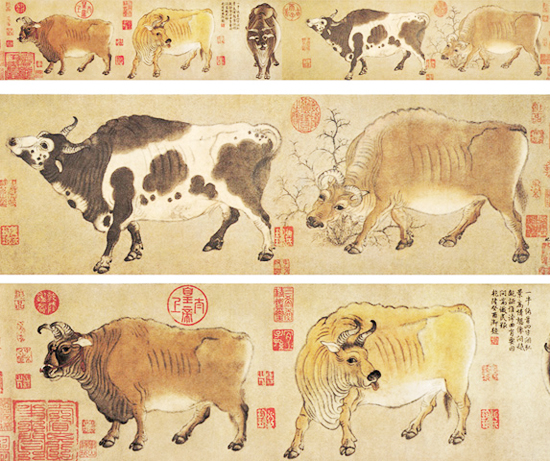Top 10 Chinese paintings (X):Five Oxen

Five Oxen
Five Oxen, a painting by renowned Tang Dynasty (618-907) artist Han Huang (723-787), is currently housed at the Palace Museum in Beijing and lauded as a “treasure” of China, but the priceless artifact almost perished during its turbulent history.
Han Huang (courtesy name Taichong) was born in Chang’an (modern-day Xi’an, Shaanxi Province) during the reign of Emperor Xuanzong (685-762), and served as a chancellor during the reign of Emperor Dezong (742-805).
Han was renowned for painting people and animals with detailed facial expressions. He was especially distinguished at painting agricultural life and livestock, including oxen and goats.
Five Oxen is 139.8 centimeters long and 20.8 centimeters wide. The painting, as the name suggests, is of five oxen without any background. The oxen are positioned in a line, each with distinctive appearance, walking or standing, holding their heads high or low. The oxen have bright, piercing eyes and different temperaments: lively, docile, romping and even eccentric.
Han used simple lines and smooth yet forceful strokes to depict the stubbornness, strength and sluggishness of oxen. The painter vividly depicted the bones and muscles of the oxen and elaborately delineated the tiny hairs on their heads and around their muzzles. With vivid modeling, simple colors and rich gradations, the painting combines appearance perfectly with spirit.
The ox is a classical subject in traditional Chinese painting, manifesting China’s agriculture-oriented culture, which is deemed the foundation of society. As a chancellor, Han emphasized agricultural development. His painting might even be meant to encourage agriculture.
The painting was praised by artists and collectors. According to records in the Ming Dynasty (1368-1644), the painting was taken to the imperial storehouse during the Northern Song Dynasty (960-1127). Emperor Huizong (1082-1135) of Song had his inscription written on it, which was cut off by later generations.
During the Yuan Dynasty (1271-1368), celebrated painter Zhao Mengfu (1254-1322) acquired the painting and treated it as a treasure, leaving his postscript on it. In the Ming Dynasty, the painting was handed down to collector and connoisseur Xiang Yuanbian (1525-90) and then poet Song Luo (1634-1713).
During the Qing Dynasty (1616-1911), the painting was taken to the imperial palace, according to an imperial edict by Emperor Qianlong (1711-99). During the late Qing Dynasty, it was taken to Yingtai in Zhongnanhai for storage. The painting was then lost during the occupation of Beijing by the Eight-Nation Alliance in 1900.
In early 1950s, Premier Zhou Enlai received a letter from a patriotic collector in Hong Kong, who said he had discovered the painting. Zhou instructed the Ministry of Culture to verify the painting’s authenticity and bring it back at all costs.
Although the painting returned to China, it was severely damaged. In 1977, the painting was sent to the Palace Museum to be restored to its present form.
